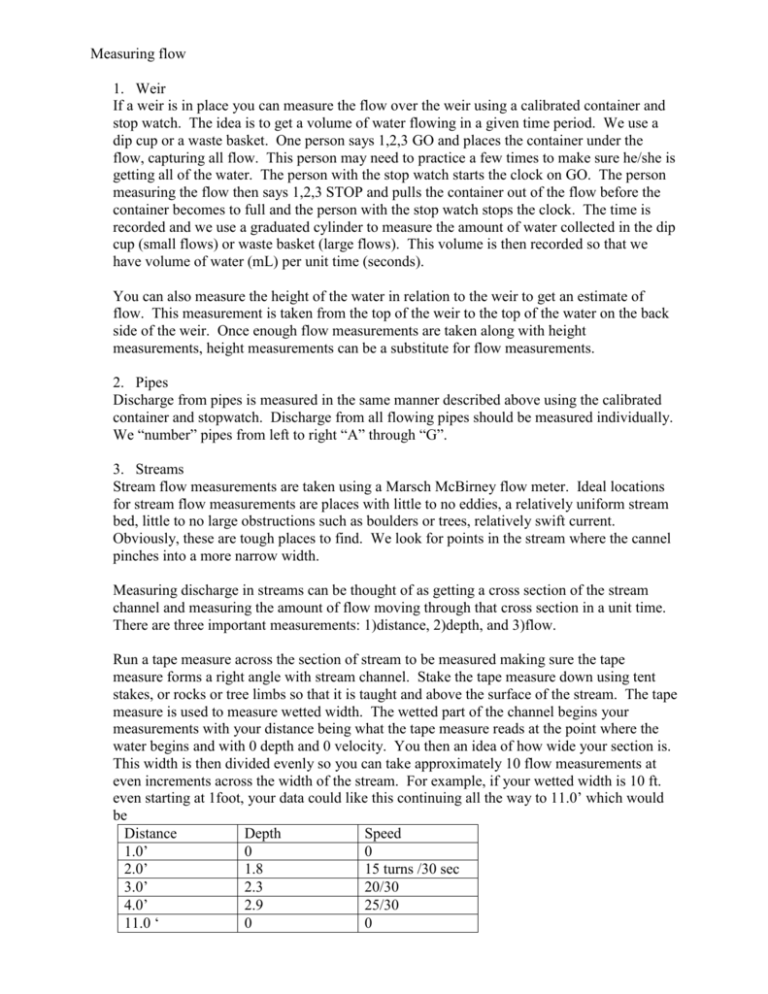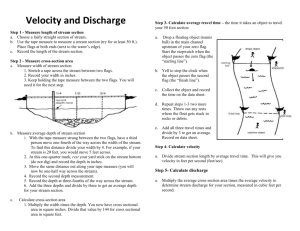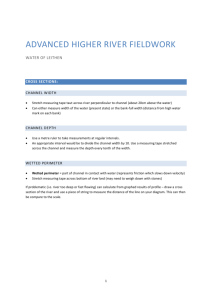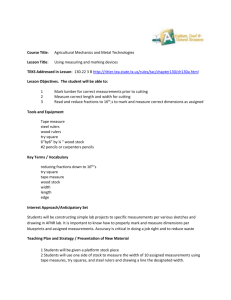Measuring flow
advertisement

Measuring flow 1. Weir If a weir is in place you can measure the flow over the weir using a calibrated container and stop watch. The idea is to get a volume of water flowing in a given time period. We use a dip cup or a waste basket. One person says 1,2,3 GO and places the container under the flow, capturing all flow. This person may need to practice a few times to make sure he/she is getting all of the water. The person with the stop watch starts the clock on GO. The person measuring the flow then says 1,2,3 STOP and pulls the container out of the flow before the container becomes to full and the person with the stop watch stops the clock. The time is recorded and we use a graduated cylinder to measure the amount of water collected in the dip cup (small flows) or waste basket (large flows). This volume is then recorded so that we have volume of water (mL) per unit time (seconds). You can also measure the height of the water in relation to the weir to get an estimate of flow. This measurement is taken from the top of the weir to the top of the water on the back side of the weir. Once enough flow measurements are taken along with height measurements, height measurements can be a substitute for flow measurements. 2. Pipes Discharge from pipes is measured in the same manner described above using the calibrated container and stopwatch. Discharge from all flowing pipes should be measured individually. We “number” pipes from left to right “A” through “G”. 3. Streams Stream flow measurements are taken using a Marsch McBirney flow meter. Ideal locations for stream flow measurements are places with little to no eddies, a relatively uniform stream bed, little to no large obstructions such as boulders or trees, relatively swift current. Obviously, these are tough places to find. We look for points in the stream where the cannel pinches into a more narrow width. Measuring discharge in streams can be thought of as getting a cross section of the stream channel and measuring the amount of flow moving through that cross section in a unit time. There are three important measurements: 1)distance, 2)depth, and 3)flow. Run a tape measure across the section of stream to be measured making sure the tape measure forms a right angle with stream channel. Stake the tape measure down using tent stakes, or rocks or tree limbs so that it is taught and above the surface of the stream. The tape measure is used to measure wetted width. The wetted part of the channel begins your measurements with your distance being what the tape measure reads at the point where the water begins and with 0 depth and 0 velocity. You then an idea of how wide your section is. This width is then divided evenly so you can take approximately 10 flow measurements at even increments across the width of the stream. For example, if your wetted width is 10 ft. even starting at 1foot, your data could like this continuing all the way to 11.0’ which would be Distance Depth Speed 1.0’ 0 0 2.0’ 1.8 15 turns /30 sec 3.0’ 2.3 20/30 4.0’ 2.9 25/30 11.0 ‘ 0 0 Flow measurements are taken at 60% depth. This is determined by measuring the depth of the water using a wading rod and then placing the velocity measurer (either bulb or whirly gig) at 60% depth using the wading rod measurements. Distance (using the tape measure), depth (using the wading rod) and velocity (using bulb or whirly gig) is recorded at even increments along the tape measure until you reach the other side of the wetted width at 0 depth and 0 velocity. We use a whirly gig and so we record velocity as “turns per 30 seconds”. Other meters simply give you the velocity. Hints: the flow meter should always be perpendicular to the main flow in that particular section. Make sure your units are consistent. We use decimal feet for distance and depth measurements. The diagram below may help you to visualize the process. Length from bank to bank is wetted width Begin of wetted width: 0 depth and 0 velocity Tape Measure Stream bottom Depth Distance from one bank (either is fine) would be measured using the red tape measure in this figure. At each blue line, depth and speed would be measured using the wading rod and flow meter.







